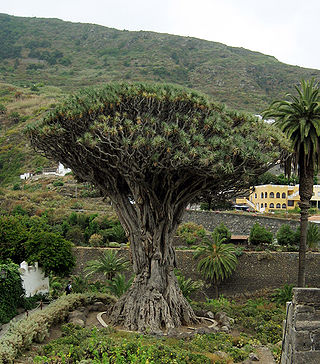
Dracaena is a genus of about 120 species of trees and succulent shrubs. The formerly accepted genera Pleomele and Sansevieria are now included in Dracaena. In the APG IV classification system, it is placed in the family Asparagaceae, subfamily Nolinoideae. It has also formerly been separated into the family Dracaenaceae or placed in the Agavaceae.

Sansevieria is a historically recognized genus of flowering plants, native to Africa, notably Madagascar, and southern Asia, now included in the genus Dracaena on the basis of molecular phylogenetic studies. Common names for the 70 or so species formerly placed in the genus include mother-in-law's tongue, devil's tongue, jinn's tongue, bow string hemp, snake plant and snake tongue. In the APG III classification system, Dracaena is placed in the family Asparagaceae, subfamily Nolinoideae. It has also been placed in the former family Dracaenaceae.

Dracaena angolensis, commonly known as African spear or the spear sansevieria, is a succulent plant native to Angola in Southern Africa. For years, it was placed within the genus Sansevieria (snake-plants), a specific name which is still used synonymously by some; in the 21st century, Sansevieria became part of Dracaena (dragon-trees), after improved testing methods, physical comparisons, and other analyses found sufficient commonalities between the two genera to warrant subsumption.

In botany, succulent plants, also known as succulents, are plants with parts that are thickened, fleshy, and engorged, usually to retain water in arid climates or soil conditions. The word succulent comes from the Latin word sucus, meaning "juice" or "sap".
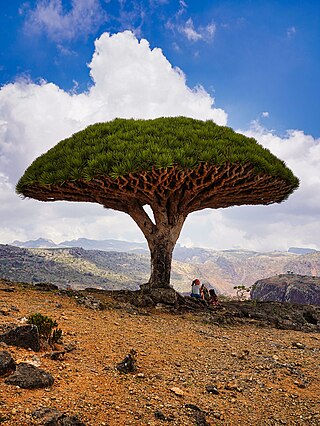
Dracaena cinnabari, the Socotra dragon tree or dragon blood tree, is a dragon tree native to the Socotra archipelago, part of Yemen, located in the Arabian Sea. It is named after the blood-like color of the red sap that the trees produce. It is considered the national tree of Yemen.

Dracaena pethera, synonym Sansevieria kirkii, also known as star sansevieria, is a succulent plant native to Tanzania and the surrounding region in East Africa.
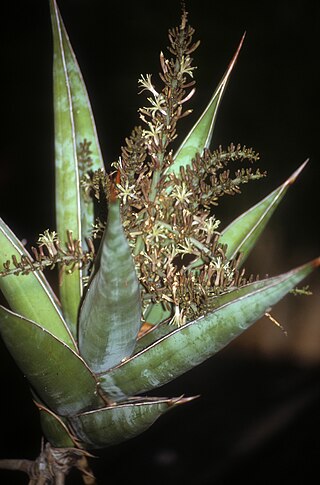
Dracaena pinguicula, synonym Sansevieria pinguicula, also known as the walking sansevieria, is a xerophytic CAM succulent native to the Bura area of Kenya, near Garissa. The species was described by Peter René Oscar Bally in 1943.
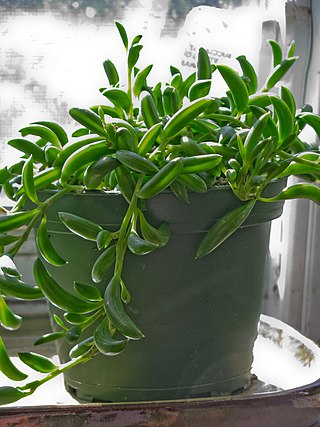
Curio radicans, syn. Senecio radicans, is a succulent houseplant that is native to Southern Africa. A member of the family Asteraceae, the asters, this species is closely related to the common string of pearls and Curio hallianus. It has multiple tendrils of glossy, banana-shaped foliage. It is commonly known as string of bananas or fishhook senecio.

Dracaena eilensis, synonym Sansevieria eilensis, is a species of succulent plant native to a small region of Somalia near the town of Eyl. The species was collected in 1973 by John Lavranos.

Echeveria strictiflora, the desert savior, is a species of flowering plant in the family Crassulaceae, native to southwestern Texas and to the Chihuahuan Desert of northeast Mexico. Its range consists of several scattered populations, rather than a contiguous range.

Dracaena arborescens, synonym Sansevieria arborescens, is a succulent plant native to Kenya and Tanzania.

Dracaena bagamoyensis, synonym Sansevieria bagamoyensis, also known as snake plant is a succulent plant native to Kenya and Tanzania.

Haworthia floribunda is a species of succulent plant in the genus Haworthia native to the Cape Province of South Africa. It grows in rosettes with dark green, lanceolate leaves that curve or twist outward. The leaves may be smooth or, in H. floribunda var. dentata, have small teeth.
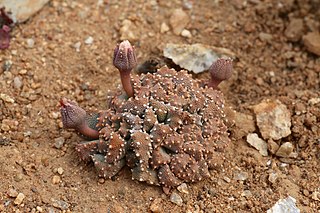
Aloinopsis luckhoffii is a species of succulent plant in the genus Aloinopsis native to South Africa. Like other Aloinopsis it grows in a rosette of leaves close to the ground. It has angular leaves that are covered by small, white tooth-like protrusions.
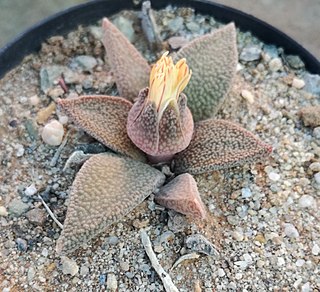
Aloinopsis rubrolineata is a species of succulent plant in the genus Aloinopsis native to South Africa. It grows in a branching habit low to the ground, and has leaves covered with small, round tubercles. The leaves are dark olive green and tongue-like in shape. Its scientific name refers to its flowers, which have a distinctive red stripe.

Dracaena hallii is a species of succulent plant native to Mozambique, Zimbabwe, and Limpopo Province of South Africa. The species was named for Harry Hall, formerly the curator of succulents at Kirstenbosch National Botanical Garden in Cape Town. Commonly known as the "baseball bat" plant, it has extremely thick foliage with a rounded shape and a central channel.

Dracaena singularis is a species of succulent plant in the genus Dracaena native to Ethiopia, Kenya, and Tanzania. Mistakenly placed in the genus Boophane at first, by the 1980s the plant was corrected to be in the genus Sanseviera, until that entire genus was merged with Dracaena. The species is named singularis since at its mature size, it has only a single leaf up to 1.8 metres (5.9 ft) in length, while in a juvenile state it displays small rosettes of several leaves.

Dracaena ballyi is a species of succulent plant native to Kenya and Tanzania. It grows in small rosettes with leaves that have bands of color and sharp tips. Originally collected by Peter Bally in 1963 and long cultivated as a houseplant, it was scientifically described in 2004.
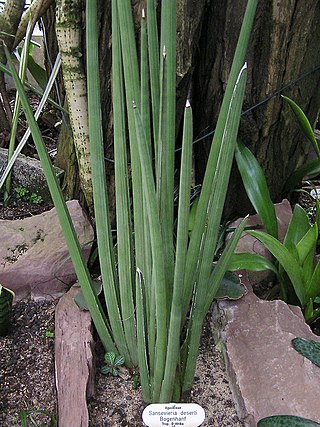
Dracaena pearsonii is a species of succulent plant native to Southern Africa. This species is in a complex of plants including Dracaena stuckyi and Dracaena angolensis that are characterized by their cylindrical leaves that grow upright in a spear-like habit. It grows in desert or dry shrubland, has thick rhizomes that produce offsets.

Dracaena aethiopica is a species of succulent plant widely distributed in Southern Africa. Its binomial name—aethiopica—refers to its origins in Africa. A highly variable species, it grows in desert or dry shrubland and spreads rhizomatically. The leaves grow in rosettes and may be up to 70 centimetres (2.3 ft) tall. Genetically, this species is most closely related to Dracaena ballyi. In Africa, this species has been used to augment poisons for hunting and fishing purposes.




















